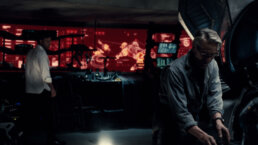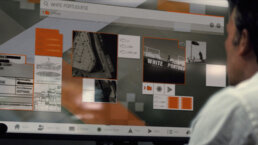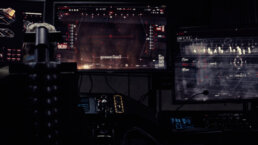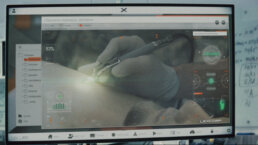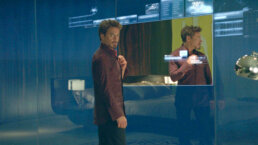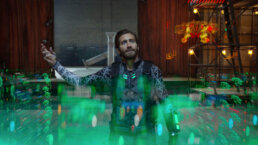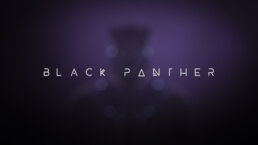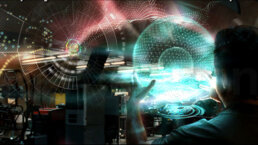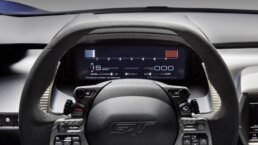For years, technology has been a driving element in science fiction films. Whether it aids the hero in building their super powered suit or is the one thing the villain needs to help them carry out their wicked plan, technology offers the audience a deeper look at the film’s characters, personality and style.
Our team at Perception has been designing technology for heroes and villains for nearly 15 years. When we approach these projects, we see technology as a multilayered element that communicates a statement about the setting’s technological climate and further supports the world-building of the film. Beyond that, technology plays a critical role in branding a character’s identity, in a similar way to how it defines our own identities.
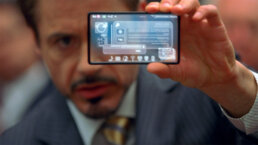
Technology is all around us. We all have phones, computers, and gadgets that we use in our everyday lives and these pieces of technology are often personalized to us. We each have our own unique phone backgrounds, our own apps that we love to use, our own protective cases that define our style. As unnoticed as they may go, our technology sends a message about who we are.
Film characters are no different, especially science fiction characters. The way a character’s technology looks and operates can inform the audience of who this character is, especially in a fight of good versus evil.
Designing technology for heroes and villains gives our team the opportunity to take a deep dive into the identities of these characters, their motivations, their history and what makes them unique. We always begin by going back to the source material and studying their previous appearances in film, comics, television, as well as reading the scripts for the current project.
We ask ourselves questions to try and get to the core of who the character is. Is this character a good guy or a bad guy? Do they think they are righteous or know they are evil? Are they a genius, billionaire, playboy, philanthropist or are they a secret nazi AI hiding in a machine? We look at the characters’ homes, lairs and vehicles to see how their personality impacts their exterior environment. We build lists of identifying characteristics to see how we can apply that to the aesthetic of the character’s technology.
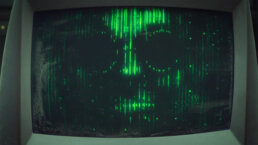
Everything we create is driven by the character. It’s easy to say that a villain’s technology should be red and black and have sharp edges, while a hero’s technology should be bright and inviting and user friendly. But that rarely gets to the core of who the character is and is oftentimes far too expected.
One of the best examples of this is Batman vs Superman: Dawn of Justice. We conceptualized Batman’s interfaces and tech for the Batcave and Batmobile, and we also crafted Lex Luthor’s operating system. These two characters completely flip the script from what is expected. Batman is a dark, gritty hero and his technology reflects that. He utilizes dark screens with red highlights and a very blueprint utilitarian inspired aesthetic. Meanwhile, Lex Luthor’s OS is clean, crisp and enhanced with a white and gray color scheme.
This is the exact opposite of what should be expected from a hero and villain. The hero has the dark, menacing technology while the villain has the light, clean technology, but that matches the personality and style of their characters. It is a secondary way of branding the character beyond their own appearance. If their personality and style bleeds into their technology, it reinforces who that character is at their core.
Audiences love knowing these characters. When I’m watching a film, I want to feel totally immersed in that world and that character’s story. If a character is interacting with personalized technology, I feel a better connection to that character because it gives their story more depth. It’s a quick way for the audience to learn more about the person they’re supposed to support or dislike.
Tony Stark uses incredibly advanced and unparalleled technology that he builds himself, showcasing his wealth, intelligence and engineering skills. Mysterio uses hacking and deception technology inspired by Stark Technology, indicating his jealousy of Tony Stark and his motivations. Each facet of this technology shows what the audience needs to know about these characters and informs their opinions on them, their fight, and if it’s a cause they would fight for too.
At the heart of technology is the character who creates and uses them. In our world, we create technology based on our wants and needs, and film characters are no different. A hero creates technology to help save the world and the villain creates technology to help fight the hero. That technology defines who they are and it’s our job to align those functions and aesthetics with the character’s identity. So next time you’re watching a sci-fi film on the big screen, take a closer look at the technology and see what details and characteristics it reveals about the person using it.
Doug Appleton
Doug Appleton is Perception’s resident VFX wizard. Formally taught in the world of motion graphics, Doug’s first job out of college was at Perception. He has been with the studio ever since.
Doug has grown with the team from their early days and has continued to flourish up the hierarchy as he learns and masters the intricacies of the film and technology worlds. His skill in successfully executing a diverse array of projects in the world of motion is matched only by his curiosity of the technology itself.
Doug’s projects have ranged from detailed UX interface projects for high profile security clients, to lead animator on title sequences for Avengers: Age of Ultron. As a director he often works with his team and clients to problem solve as a unit, encouraging collaboration and confidence.
In addition to VFX guru, Doug is also Perception’s resident Marvel database. A huge fan of the series and of exploring the unknown, Doug likes to collect memorabilia from all major projects, with the love and support of his wife and two feline friends. He is also known as “The Encyclopedia”.
